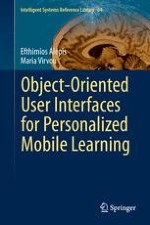2014 | OriginalPaper | Buchkapitel
10. Mobile Affective Education
verfasst von : Efthimios Alepis, Maria Virvou
Erschienen in: Object-Oriented User Interfaces for Personalized Mobile Learning
Verlag: Springer Berlin Heidelberg
Aktivieren Sie unsere intelligente Suche, um passende Fachinhalte oder Patente zu finden.
Wählen Sie Textabschnitte aus um mit Künstlicher Intelligenz passenden Patente zu finden. powered by
Markieren Sie Textabschnitte, um KI-gestützt weitere passende Inhalte zu finden. powered by
